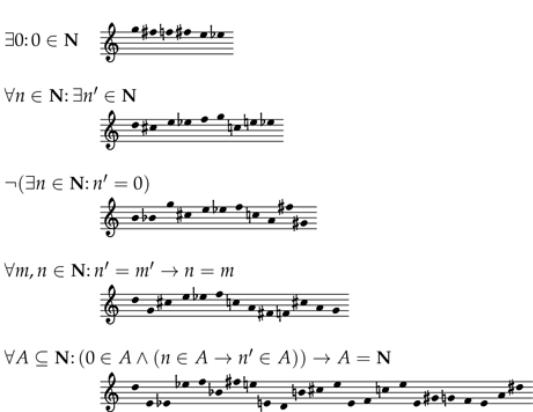The links between mathematics and music are manifold. Mathematics can be set to music in a simple but surprising manner. For the award ceremony of the Gödel Medal in 2014, a musical interpretation of Gödel’s incompleteness Theorems was written by Danish composer Niels Marthinsen. It encodes the basic axioms of number theory that form the focus of Gödel’s Theorems.

Creation or Invention?
Mathematics lies somewhere within a space covering both the arts and sciences. It has a major role in all the quantitative sciences, but aesthetic considerations are also of central importance in both pure and applied mathematics. There is perennial discussion as to whether mathematics is created, like works of art, or discovered, as in the natural sciences. There are arguments in support of both viewpoints.
To Leopold Kronecker, a 19th century German mathematician who worked on number theory and algebra, is attributed the statement “God made the integers, all else is the work of man”. This might suggest that the integers, the positive and negative whole numbers, were discovered and the other numbers, fractions, square roots, π and so on, were created. But it is arguable that, since the properties of these numbers follow from those of the whole numbers, their emergence was more discovery than invention.
Peano’s Axioms

Can we deduce the properties of the numbers from a small collection of fundamental principles? In 1889, the Italian mathematician Giuseppe Peano proposed a set of postulates which enabled the system of natural numbers, and much more besides, to be constructed via mathematical logic. These postulates have been used more-or-less the same form ever since, and are known as the Peano axioms.
The Peano axioms define the arithmetical properties of natural numbers, N. They are very basic and acceptable on intuitive grounds. They start by assuming that 0 is a natural number. Then, each natural number is assumed to have a successor: n’ ( = n + 1 follows n). Finally an additional axiom, called the axiom of induction, is required: if a set of numbers includes 0 and also the successor of every number, then it contains every natural number. The five axioms are:
P1: There exists a number 0 in the set N
P2: Every n in N has a successor n’ in N
P3: 0 is not the successor of any number in N
P4: If the successor of m and n are equal, then so are m and n
P5: If a subset A of N contains 0 and, for every n in A, n’ is also in N, then A is equal to N.
In symbolic form, the Peano Axioms may be expressed as follows:

Incompleteness
Peano’s axioms imply that the set of natural numbers is infinite. Using them, we can define the operations of addition and multiplication and the usual ordering of the natural numbers. Many mathematical results can be proved using the axioms. However, to produce the complete body of mathematical results, a more powerful system of axioms, such as the so-called Zermelo–Fraenkel system, is required.
When Peano announced his set of axioms, most mathematicians agreed that they faithfully characterised the natural numbers. However, some, including Henri Poincaré, were concerned about whether they were free from contradictions? One of the 23 problems posed by David Hilbert in 1900 was to prove consistency of the Peano axioms. Thirty years later, Kurt Gödel showed that such a consistency proof cannot be formalized within Peano arithmetic itself.
The overwhelming majority of contemporary mathematicians are happy to regard Peano’s axioms as consistent. However, a tiny minority, the ultra-finitists, refuse to accept the existence of the (infinite)
set of natural numbers, on the grounds that it can never be completed.
Musical Encoding
The idea of interpreting Peano’s axioms in musical form is to assign a musical note to each logical symbol. Eighteen symbols are used in the expression of the axioms, and several encodings were used, the simplest being shown here:

The symbols are mapped onto a sequence of notes from G5 to D4, descending in semitones. With this encoding, the five axioms shown above correspond to “tone-rows”:

In principle, a vast body of mathematics can be derived directly from the axioms. All the proofs and results can be musically encoded in this way. The composer Niels Marthinsen combined his composition with the text of a poem “The Hilbert Heartbreak Hotel”, which is based on the paradoxes arising when a hotel is assumed to have an infinite number of rooms.
The encoding into musical notes is analogous to the numbering system introduced by Gödel. He assigned a number sn to the n-th logical symbol. Then a string of k symbols would correspond to a k-tuple ( s1, s2, … , sk ) and Gödel represented this by a single number G = 2^s1 3^s2 … pn^sn, where pn is the n-th prime number.
Sources
- Philip Ball, 2014: Enigmatic foundations of maths put to music. News item. Nature, 3 July 2014. DOI:10.1038/nature.2014.15502
-
Rasmus Glistrup: The Music in Gödel Theories. ITU Copenhagen. Written July 15, 2014.
